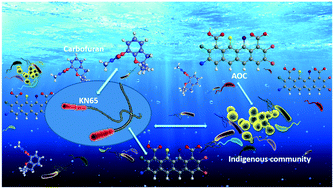Modelling carbofuran biotransformation by Novosphingobium sp. KN65.2 in the presence of coincidental carbon and indigenous microbes†
Abstract
The influence that coincidental carbon substrates (i.e., assimilable organic carbon, AOC) and indigenous microbial communities has on pesticide biotransformation by degrader strains in aquatic environments is poorly understood. We conducted batch experiments to investigate carbofuran biotransformation by Novosphingobium sp. KN65.2 using four environmentally derived water samples with varying amounts and types of AOC and indigenous microbial communities. We designed experimental scenarios to explore the influence of AOC and indigenous microbial communities on the growth of strain KN65.2 and the biotransformation of carbofuran. Relevant kinetic parameters were estimated from simpler experiments, and used to predict the growth of strain KN65.2 and the biotransformation of carbofuran in more complex experiments with an additive biokinetic model. We found that an additive biokinetic model adequately predicts the growth of strain KN65.2 and the rate of carbofuran biotransformation in natural waters that support the growth of strain KN65.2. However, our model over-predicts the growth of strain KN65.2 and the rate of carbofuran biotransformation in low-AOC environments. Overall, our results define the scope within which additive biokinetic models can be used to predict pesticide biotransformation in the presence of coincidental carbon substrates and indigenous microbial communities.



 Please wait while we load your content...
Please wait while we load your content...